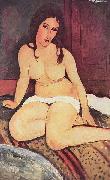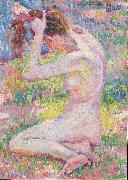Wholesale Oil Painting No Minimum |
|||||||||||
|
|
|||||||||||

|
|||||||||||
|
|
|
||||||||
Amedeo ModiglianiItalian Expressionist Painter and Sculptor, 1884-1920 Amedeo Clemente Modigliani (July 12, 1884 ?C January 24, 1920) was an Italian artist of Jewish heritage, practicing both painting and sculpture, who pursued his career for the most part in France. Modigliani was born in Livorno (historically referred to in English as Leghorn), in northwestern Italy and began his artistic studies in Italy before moving to Paris in 1906. Influenced by the artists in his circle of friends and associates, by a range of genres and art movements, and by primitive art, Modigliani's œuvre was nonetheless unique and idiosyncratic. He died in Paris of tubercular meningitis, exacerbated by poverty, overworking, and an excessive use of alcohol and narcotics, at the age of 35. |
||||||||
|
|
||||||||
Sitzender Akt
Sitzender Akt Painting ID:: 74493 |
1917
Oil on canvas
114 X 75 cm
cjr 1917 Oil on canvas 114 X 75 cm cjr |
|||||||
|
|
||||||||
Theo Van RysselbergheBelgian Pointillist Painter, 1862-1926 was a Belgian neo-impressionist painter, who played a pivotal role in the European art scene at the turn of the century. Born in Ghent to a French-speaking bourgeois family, he studied first at the Academy of Ghent under Theo Canneel and from 1879 at the Academy of Brussels under the directorship of Jean-François Portaels. The North African paintings of Portaels had started an orientalist fashion in Belgium. Their impact would strongly influence the young Theo van Rysselberghe. Between 1882 and 1888 he made three trips to Morocco, staying there a total of one year and half. Barely 18 years old, he already participated at the Salon of Ghent, showing two portraits. Soon afterwards followed his Self-portrait with pipe (1880), painted in somber colours in the Belgian realistic tradition of that time. His Child in an open spot of the forest (1880) already departs from this style and he sets his first steps towards impressionism. |
||||||||
|
|
||||||||
|
|
Sitzender Akt
Sitzender Akt Painting ID:: 86196 |
1905(1905)
Medium Oil on cardboard
Dimensions 37 x 26.5 cm (14.6 x 10.4 in)
cyf 1905(1905) Medium Oil on cardboard Dimensions 37 x 26.5 cm (14.6 x 10.4 in) cyf |
||||||
|
|
||||||||
|
Theo Van Rysselberghe Belgian Pointillist Painter, 1862-1926 was a Belgian neo-impressionist painter, who played a pivotal role in the European art scene at the turn of the century. Born in Ghent to a French-speaking bourgeois family, he studied first at the Academy of Ghent under Theo Canneel and from 1879 at the Academy of Brussels under the directorship of Jean-François Portaels. The North African paintings of Portaels had started an orientalist fashion in Belgium. Their impact would strongly influence the young Theo van Rysselberghe. Between 1882 and 1888 he made three trips to Morocco, staying there a total of one year and half. Barely 18 years old, he already participated at the Salon of Ghent, showing two portraits. Soon afterwards followed his Self-portrait with pipe (1880), painted in somber colours in the Belgian realistic tradition of that time. His Child in an open spot of the forest (1880) already departs from this style and he sets his first steps towards impressionism. Sitzender Akt 1905(1905) Medium Oil on cardboard Dimensions 37 x 26.5 cm (14.6 x 10.4 in) cyf |
||||||||
|
|
||||||||
|
Prev Next
|
||||||||
|
|
||||||||
|
Related Paintings to Theo Van Rysselberghe :. |
||||||||
|
|
||||||||
|
CONTACT US |


